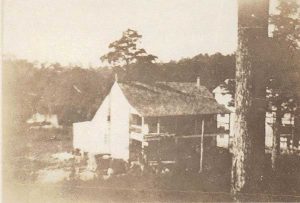





 From the late 1920s until the early 1940s there was a store in a converted warehouse run by Rufus Martin. It was located on the northeast side of the road prior to crossing the bridge. He made two bedrooms and a living room upstairs with the store area and a kitchen downstairs. Two different pictures show the store with a flat roof and later an A-line roof indicating the renovations. Gas was sold here from a tank with a hand pump. William Baker, a cousin, lived with him and helped run the store. Rufus had also run stores in Chuckatuck and Exit for awhile. When Rufus died in 1939 William went to work for W. K. Wagner in a store on the other side of the creek. J.R. Kirk bought the Martin store and Clifton Morgan ran it for awhile and, later, Ercelle Copeland. Ercelle said it stopped being operated as a store in October 1943. It was torn down about 1944. The left over stock was in the Kirk garage at one time. Lynn Rose remembers cards of buttons, aspirin, bottles holding various items, etc. (insert picture showing this store)
From the late 1920s until the early 1940s there was a store in a converted warehouse run by Rufus Martin. It was located on the northeast side of the road prior to crossing the bridge. He made two bedrooms and a living room upstairs with the store area and a kitchen downstairs. Two different pictures show the store with a flat roof and later an A-line roof indicating the renovations. Gas was sold here from a tank with a hand pump. William Baker, a cousin, lived with him and helped run the store. Rufus had also run stores in Chuckatuck and Exit for awhile. When Rufus died in 1939 William went to work for W. K. Wagner in a store on the other side of the creek. J.R. Kirk bought the Martin store and Clifton Morgan ran it for awhile and, later, Ercelle Copeland. Ercelle said it stopped being operated as a store in October 1943. It was torn down about 1944. The left over stock was in the Kirk garage at one time. Lynn Rose remembers cards of buttons, aspirin, bottles holding various items, etc. (insert picture showing this store)
To show the goodness of these merchants we quote Stokes Kirk who with his father employed close to 100 people after the depression to work on the farms as well as in the cotton gin and sawmill. “In 1933 and 1934 the lumber business was paramount. Dad had built the office at the edge of the road next to the saw mill. Cotton was still being ginned when the bank holiday came along. There was no more money that could be transferred. The two store owners, Rufus Martin and W. K. Wagner, agreed to honor requests to grant our employees groceries up to a certain amount in dollars. After the bank holiday was over, we paid for the orders or requests by check. Then Roosevelt’s “National Recovery Act” became law and business began to gradually improve.” Note: Wikipedia states that the Emergency Banking Act “Bank Holiday” (the official title of which was the Emergency Banking Relief Act) was an act of the United States Congress spearheaded by President Franklin D. Roosevelt during the Great Depression. It was passed on March 9, 1933. The act allowed a plan that would close down insolvent banks and reorganize and reopen those banks strong enough to survive.)
